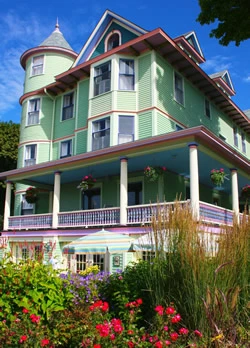Why is Mackinac Island Famous for Fudge
Introduction
Michigan’s Mackinac Island is a little, quaint island. It is renowned for its car-free streets and picturesque surroundings. Visitors explore the island on foot, bikes, or horse-drawn carriages. But one thing stands out—Mackinac Island fudge.
This delicious confection has served as an emblem of the island for more than a century. Tourists from all over the U.S. visit just for the fudge. But how did this island become the “Fudge Capital of the World”? Let’s explore Mackinac Island fudge’s history and customs.
The Origins of Mackinac Island Fudge
In America, fudge has existed since the late 1800s. Some say it was first made by accident when a caramel recipe failed. The mistake turned into a rich, creamy treat that people loved.
On Mackinac Island, fudge-making started in the late 1800s. Skilled confectioners set up small shops, selling sweets to locals and visitors. Henry Murdick was one of the first to introduce fudge to the island. In 1887, he opened Murdick’s Candy Kitchen, bringing his family’s recipes.
The cool island air played a big role in fudge-making. Candy makers discovered that fresh lake breezes helped set the fudge perfectly. Soon, they began making it in large batches on marble slabs. This technique gave Mackinac Island fudge its signature smooth texture.
More fudge shops opened as tourists increased. Generation after generation, families handed down their trade secrets. Over time, Mackinac Island became famous for its one-of-a-kind fudge.
The Rise of “Fudgies” – A Sweet Tourist Tradition
The term “Fudgies” is a fun nickname for tourists who visit for fudge. The name started in the mid-1900s when visitors came in large numbers. They would line up at fudge shops, watching candy makers at work. The tradition of buying and bringing home fudge became popular.
Mackinac Island fudge wasn’t just a treat—it became a souvenir. Tourists took it home as a sweet memory of their trip. Some even returned to the island every year just for the fudge.
Fudge quickly became a must-have when visiting Mackinac Island. Shops began offering free samples, drawing even more visitors. Today, over 10,000 pounds of fudge are made every day in peak season. The love for Mackinac fudge continues to grow, keeping this sweet tradition alive.
The Art & Business of Mackinac Island Fudge
The Art of Making Mackinac Island Fudge
Fudge from Mackinac Island is more than just a delicious dessert. It is a carefully crafted dessert made with skill and tradition. The fudge-making process has remained almost unchanged for over a century.
It all starts with high-quality ingredients—sugar, butter, cream, and chocolate. In a big copper kettle, these components are melted together. An exact temperature is then reached by heating the combination. This step ensures the perfect balance of texture and flavor.
Once cooked, the hot fudge is poured onto a marble slab. This is where the magic happens. The marble cools the fudge while keeping it smooth and creamy. Skilled fudge makers use paddles to fold and shape the fudge. This is a very precise technique that takes around 20 minutes.
The fudge is then cut into thick slices and left to set. Each slice is rich, dense, and packed with flavor. This old-fashioned method gives Mackinac Island fudge its signature texture. It retains its shape despite being mushy.
Live fudge-making demonstrations are a big attraction on the island. Visitors watch in awe as experts create fresh batches. The delicious aroma fills the air, making it hard to resist a taste.
Famous Fudge Shops and Their Legacy
Mackinac Island is home to several legendary fudge shops. Each has distinct flavors and recipes of its own. These companies have been run by families for many generations.
Murdick’s Fudge
The first fudge shop on Mackinac Island was called Murdick’s. Established in 1887, it set the foundation for the island’s fudge culture. Their classic flavors include chocolate, vanilla, and maple walnut.
Ryba’s Fudge
Ryba’s is known for its creamy texture and bold flavors. They use a special whipping process that makes their fudge extra smooth. Popular choices include peanut butter and double chocolate.
Joann’s Fudge
Joann’s offers over 20 flavors, including seasonal specials. They focus on high-quality ingredients and small-batch production. This ensures every piece is fresh and delicious.
These shops continue to attract thousands of visitors each year. They have turned Mackinac Island fudge into a world-famous delicacy.
The Cultural & Economic Impact of Fudge
Fudge Festival: A Celebration of Sweetness
Mackinac Island takes its love for fudge to the next level. The Mackinac Island Fudge Festival takes place on the island in August. This annual event celebrates the island’s rich fudge-making tradition.
The Mackinac Island Fudge Festival takes place on the island in August. Visitors enjoy fudge-making demonstrations, fudge-tasting contests, and even fudge-inspired drinks. Some shops introduce limited-edition flavors available only during the festival.
The Fudge Relay Race is one of the festival’s most thrilling activities. Participants run while carrying a pound of fudge, making it a fun challenge. Another favorite is the Fudge Lovers’ Feast, where guests sample different flavors.
Local musicians, street performers, and parades add to the lively atmosphere. Tourists and locals gather to celebrate Mackinac Island’s most famous treat. The festival keeps the fudge tradition alive and attracts new generations of “Fudgies.”
The Lasting Impact of Mackinac Island Fudge
On Mackinac Island, fudge is more than simply a dessert. It plays a huge role in the island’s economy and identity.
Mackinac Island welcomes hundreds of thousands of visitors annually. A lot of people come just to enjoy the fudge. Fudge shops generate millions of dollars in revenue, supporting local businesses and jobs. The industry helps sustain the island’s economy, especially during the busy summer months.
Beyond economics, fudge is a cultural symbol of Mackinac Island. Families pass down recipes and traditions through generations. Making fudge is still a significant aspect of the island’s culture.
Fudge shops also contribute to community events and charities. Many donate portions of their sales to local causes. Their commitment to the island keeps the tradition meaningful and special.
Over the years, Mackinac Island has gained national recognition for its fudge. Today, many refer to it as the “Fudge Capital of the World.” People go from all across the nation just to taste the renowned fudge.
Conclusion
Mackinac Island fudge is more than a sweet treat—it is a legacy. Fudge has influenced the island’s identity from its modest origins to its global renown. Generations of visitors have enjoyed watching, tasting, and bringing home this iconic candy.
If you ever visit Mackinac Island, don’t leave without a slice of fresh fudge. It’s a delicious tradition you won’t forget!
Category: Mackinac Island


